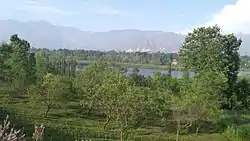Pampore
Pampar, Panpar | |
|---|---|
 View of Pampore Town in Pulwama district of the Kashmir Valley | |
| Nickname: Saffron City | |
 Pampore Location in Jammu and Kashmir, India  Pampore Pampore (India) | |
| Coordinates: 34°01′N 74°56′E / 34.02°N 74.93°E | |
| Country | |
| Union Territory | |
| Division | Kashmir |
| District | Pulwama |
| Elevation | 1,573 m (5,161 ft) |
| Population | |
| • Total | 21,680[1] |
| Demonym(s) | Pampori, Pamporiya, Pampari, Panpari, Panpariya |
| Languages | |
| • Official | Kashmiri, Urdu, Hindi, Dogri, English[2][3] |
| Time zone | UTC+5:30 (IST) |
Pampore (Urdu pronunciation: [pãːpuːr]), known as Pampar[4] (Kashmiri pronunciation: [paːmpar]) or Panpar (Kashmiri pronunciation: [pãːpar]) in Kashmiri, is a historical town situated on the eastern side of the Jhelum River on the Jammu-Srinagar National Highway. It was known as Padmanpur in antiquity.[5] It is famous worldwide for its saffron and known as the Saffron town of Kashmir. Pampore is one of the few places in the world where saffron, the world's most expensive spice, grows. Pampore, a beautiful town is famous for its saffron fields. This stunning city in Kashmir promotes itself as the "Saffron Capital of India". The area is about 11 kilometres (6.8 mi) from Srinagar city centre Lal Chowk. Areas of Pampore typically have -bal as a suffix, such as the localities of Namlabal, Kadlabal, Drangbal, Frestabal, and Letrabal. Pampore has three lakes as well which have been entitled as wetlands. One of the lakes is known as Sarbal Lake. The Sarbal Lake is situated on the way from Tulbagh to Wuyan through saffron fields near Chatlam. On the basis of its location near Chatlam, it is also known as Chatlam Wetland. Pampore also hosts a famous Muslim Shrine known as Ziyarat Hazrat Hazrat Khawaja Masood Wali Pampori (R.A) urf Khoja Sahib and Hazrat Shaykh Sharif-ud-Din Wali (R.A) urf Shog Baba Sahib. There is also historic Khanqah in Pampore built in 16th century which is named after these two sufi saints which holds holy relics of Awliya kiram. Khanqah-e-Aaliya (Khanqah-e-Masoodiya) Pampore is built by Hazrat Baba Muhammad Sadiq popularly known as Saeed Bab Sahib who was great grandson of Hazrat Khawaja Masood Wali Pampori Sahib (R.A)
Etymology
Pampore was originally called Padampur.[6]
Geography
Pampore is located at 34°01′N 74°56′E / 34.02°N 74.93°E.[7]
Demographics
As of the 2011 Indian census,[8] Pampore tehsil had a population of 60,613. Males constitute 52% of the population and females 48%. Pampore has an average literacy rate of 59%, lower than the national average of 59.5%: male literacy is 69%, and female literacy. As of 2011, Pampore town had a population of 21,680, males being 11,007 (51%) and females 10,673 (49%).[9]
Politics
Pampore is an Assembly Constituency in the Jammu and Kashmir Legislative Assembly.
See also
References
- 1 2 "Pampore Town Population". Census India. Retrieved 10 July 2021.
- ↑ "The Jammu and Kashmir Official Languages Act, 2020" (PDF). The Gazette of India. 27 September 2020. Retrieved 27 September 2020.
- ↑ "Parliament passes JK Official Languages Bill, 2020". Rising Kashmir. 23 September 2020. Archived from the original on 24 September 2020. Retrieved 30 May 2021.
- ↑ Kashir Encyclopedia (in Kashmiri). Vol. 1. Jammu and Kashmir Academy of Arts Culture and Languages. 1986. p. 86.
- ↑ Chib, Sukhdev Singh (1977). Jammu and Kashmir. Light & Life Publishers. p. 60.
The entire process of saffron growing, harvesting, picking and drying is done in Pampore, which was known as Padampur in ancient times. India is the second largest producer of Saffron in the world after Spain
- ↑ Chib, Sukhdev Singh (1977). Jammu and Kashmir. Light & Life Publishers. p. 60.
The entire process of saffron growing, harvesting, picking and drying is done in Pampore, which was known as Padampur in ancient times. India is the second largest producer of Saffron in the world after Iran and Spain
- ↑ "Maps, Weather, and Airports for Pampur, India". Faiingrain.com. Retrieved 25 March 2017.
- ↑ "Census of India 2001: Data from the 2001 Census, including cities, villages and towns (Provisional)". Census Commission of India. Archived from the original on 16 June 2004. Retrieved 1 November 2008.
- ↑ "Pampora, Municipal Committee, Pulwama, Jammu and Kashmir city population | Population of India". Archived from the original on 1 June 2014. Retrieved 1 June 2014.